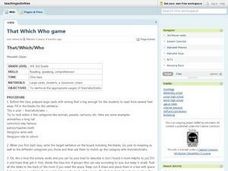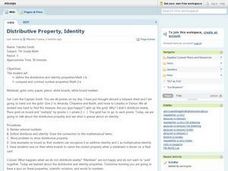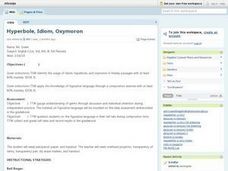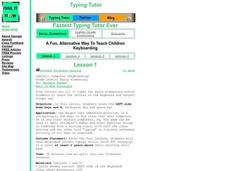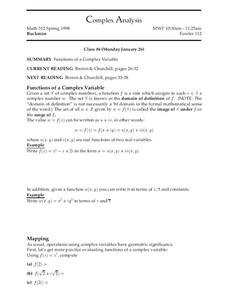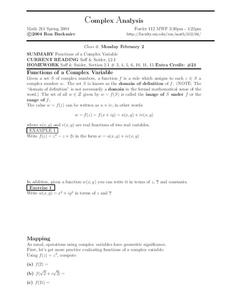Curated OER
Introductory Exponents
Pupils participate in a lesson combining language arts with mathematics. First, they write a paragraph explaining what it means to multiply two numbers. Then students practice using exponents in different problems.
Curated OER
Fractions Continued
Students investigate the concept of using fractions to solve problems involving rational numbers. They order real numbers on the number line with the classification of fractions. Also students solve problems using the four operations...
Curated OER
That/Which/Who Game
Third graders play a game to practice speaking the target language (English). They are divided into teams. One student from each team sits at the front of the room. One student reads a clue (in English)-there team receives one point for...
Curated OER
Words to Numbers
Seventh graders translate word problems into numerical expressions. Through guided practice, 7th graders discover how to take the information contained in a word problem and create a numerical expression using variables. They...
Curated OER
Paraphrasing
Seventh graders practice paraphrasing. As a class, they review previous lessons and discuss the difference between paraphrasing and plagiarism. Students begin by paraphrasing sentences orally and then they complete a worksheet,...
Curated OER
Distributive Property, Identity
Seventh graders review rational numbers. After listening to a story, 7th graders define the distributive and identity properties. They observe examples of each property and play a race game to practice identifying the properties. ...
Curated OER
Hyperbole, Idiom, Oxymoron
Fourth graders identify the usage of idiom, hyperbole, and oxymoron in literary passages. They apply this knowledge of figurative language through a composition exercise. The writing of teacher generated examples is also helpful.
Curated OER
Intro to Parts of Speech
Students are introduced to, identify and define the eight parts of speech. They view a variety of sentences and identify each word in each sentence as one of the eight parts of speech.
Curated OER
Let's go shopping
Students work in groups to write a skit in the target language (in this case, English) in which they are on a shopping trip. The teacher plays the part of the clerk. Students practice the vocabulary required, and perform their skits for...
Curated OER
Star Wars: Rays and Angles Edition
Rays and angles and Star Wars? It sounds strange, but it's actually a fun game to help fourth graders get good at measuring and identifying angles and rays with a protractor. Each pair of children chooses which Star Wars character they'd...
Super Teacher Worksheets
Improper Fractions & Mixed Numbers
Young mathematicians demonstrate their understanding of part-whole relationships in a fraction skills learning exercise. Presented with a series of mixed numbers and improper fractions, learners must correctly convert each of them...
Florida Center for Reading Research
Comprehension: Monitoring for Understanding, What Do You Know?
An activity promotes reading comprehension. Readers analyze a text of their choice while activating prior knowledge and asking and answering questions. Scholars enforce multiple strategies to improve comprehension.
Florida Center for Reading Research
Phonics: High Frequency Words, Word Bowling
Go bowling for high-frequency words! Partners take turns drawing bowling ball cards and read the word printed on them. If the learner is successful, they record their score on a scorecard.
George W. Bush Presidential Library and Museum
Teaching Primary and Secondary Sources
What makes a source primary or secondary? Middle schoolers read a definition of each term before exploring different examples and applying their knowledge to a research project.
PBS
Production
Class members investigate the different roles associated with video production. Then, they create a crash course booklet that details what they have learned about the different roles: video production, scouting locations and set up,...
TryEngineering
Data Representation: Millions of Colors
How many colors do you know? The lesson teaches scholars how digital devices use binary and hexadecimal representations to store colors. They learn how millions of colors are available on these devices.
California Department of Education
How to Succeed in Life
Is it possible that six simple traits lead to a happy, successful life? Part four of a six-part series of college and career readiness lessons examines the effects of character in determining success. Working groups discuss...
Curated OER
Computer (Keyboarding)
Students practice typing the letters on the left side of the home row of keys. They complete time tests and examine their results. They discover words from those letters as well.
Curated OER
What will you be for Halloween?
First graders construct a story sticking to the topic with 2-4 sentences.
Curated OER
Complex Analysis: Functions of Complex Variables
In this function activity, students map equations and identify three dominant characteristics. They evaluate functions of complex variables. This three-page activity contains approximately ten problems.
Curated OER
Complex Analysis: Functions of Complex Variables
For this complex variable worksheet, students explore the functions of a complex variable. They map complex variables and solve complex inequalities. This three-page worksheet contains fourteen problems.
Curated OER
Perfect Manners/Roles of Citizens
Students discuss manners and citizenship. In this roles of citizens lesson plan, students read D.W.'s Guide to Perfect Manners and create a Venn Diagram with examples from the story. Students take a quiz.
Curated OER
ESL: Weather Word Handwriting Practice
In this ESL weather words instructional activity, learners practice writing a set of 6 words, complete a 6 questions weather word spelling quiz and unscramble 6 words. A reference web site is given for additional activities.
Curated OER
Goal Setting
Pupils practice setting goals that are short and long term. They look at the goals for the cost of resources like time to reach each goal, the pros and cons are then weighed to know the context. Then the students write a reflective...


